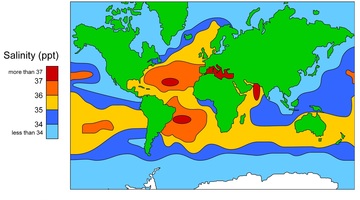Dr Phil Sutton of NIWA explains why measuring ocean salinity and temperature is important. These two measurements are closely related to water density and the formation of ocean currents. They also tell us about the exchange of water between the ocean and the atmosphere as part of the water cycle
Transcript
Dr Phil Sutton
Well obviously, the ocean is salty, but it's not uniformly – salty there are slightly fresher parts of the ocean, and slightly saltier parts. Salinity also affects the density, so basically water that is saltier is heavier, and tends to sink below water that is fresher.
So the two reasons you measure salinity – one is it tells you something about evaporation and precipitation at the surface of the ocean – so rainfall and evaporation, which are important to understand in the hydrological cycle – and the other reason you measure salinity is because of its impact on density, and basically warm water is less dense, and fresh water is less dense, and cold water is heavier, and salty water is heavier.
So the combination of temperature and salinity together, lets you calculate the density, and from the varying density field around the area, or around regions, it can tell you which way the currents are going. Temperature obviously is very useful for the density to give you something about the dynamics and how the water is moving, but temperature of course is also instantly useful for a heat content, and ocean temperature measurements for things like global warming, or decadal climate variability, El Nino cycles, things like that.
Acknowledgement
NIWA


